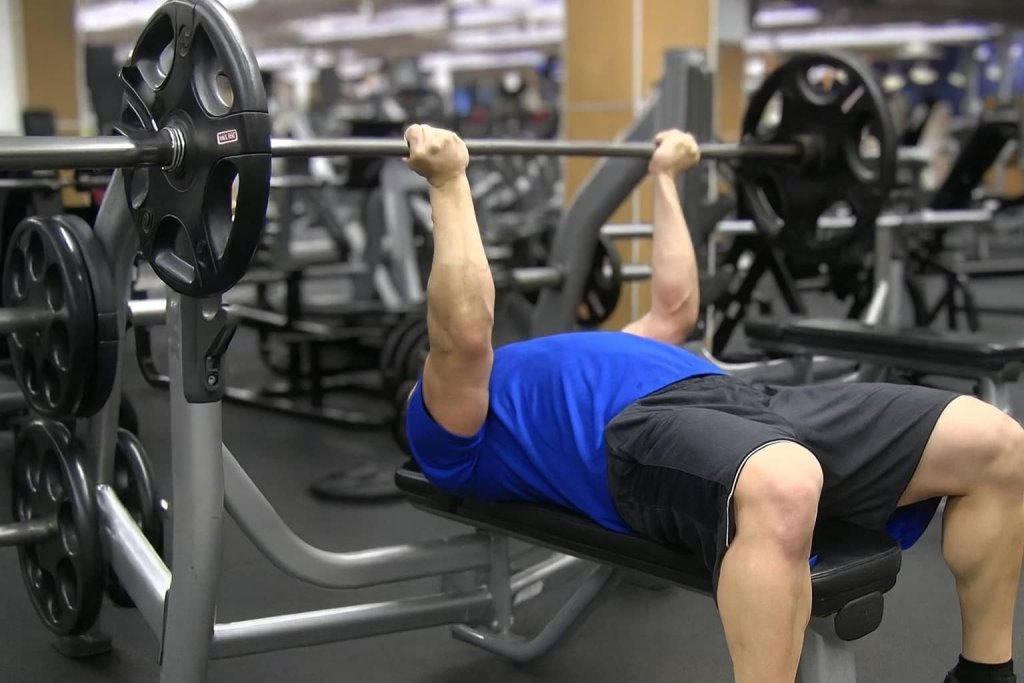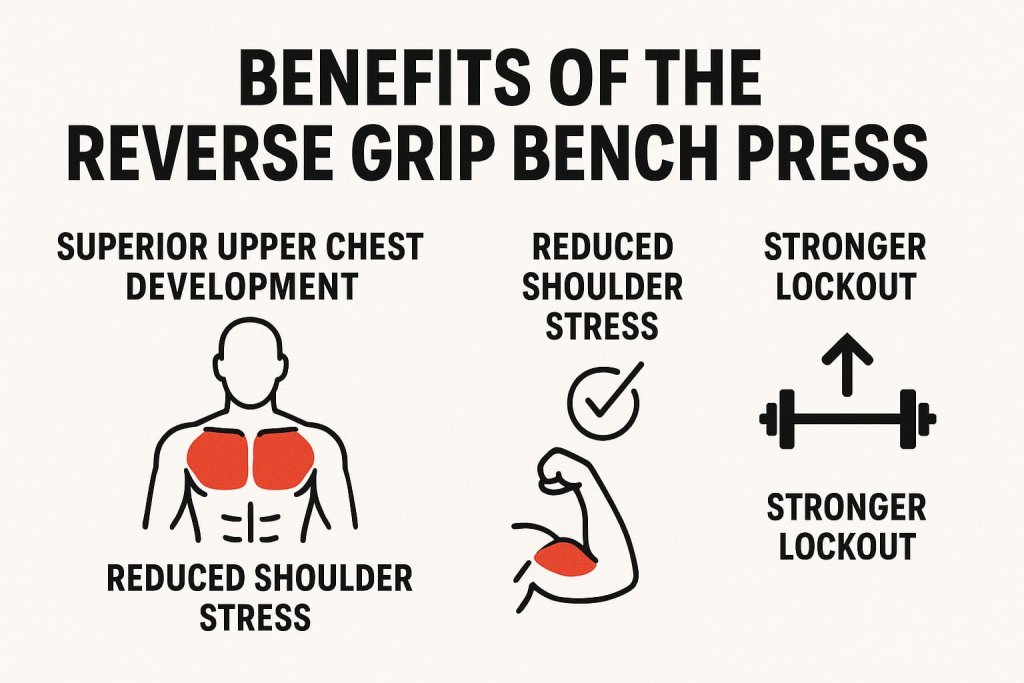The reverse grip bench press isn’t just another pressing variation—it can boost upper chest activation by around 30% compared to the traditional bench press.
This finding comes from electromyography (EMG) research, which showed significantly greater stimulation of the clavicular (upper) portion of the pectoralis major when using a supinated (underhand) grip.

For lifters aiming to maximize upper chest growth without relying solely on incline presses, understanding and mastering this movement is key. The reverse grip not only targets the upper chest more effectively but also promotes joint-friendly mechanics that may help reduce shoulder strain.
In this guide, you’ll discover the science-backed benefits, step-by-step form breakdown, effective variations, and the most common mistakes to avoid—so you can safely add this powerhouse exercise to your chest-building arsenal.
What Is the Reverse Grip Bench Press?
The reverse grip bench press is a flat barbell bench press performed with an underhand (supinated) grip, where palms face toward your head. This grip shifts the pressing angle slightly upward, increasing recruitment of the upper chest and even activating the biceps more than a traditional bench press.
Proven Upper Chest Activation
Research evidence: A Canadian Memorial Chiropractic College study found that using a reverse grip on the flat bench press produced ~30% greater EMG activity in the upper pectorals compared to a standard overhand grip.
Mechanics: The underhand grip naturally tucks the elbows and drives the bar along a low-to-high pressing path, closely mimicking the muscle recruitment pattern of an incline press—while still lying flat.
Comparison:
- Incline Bench Press: ~5–10% increase in upper pec activation.
- Reverse Grip Bench Press: ~30% increase in upper pec activation.
Benefits of the Reverse Grip Bench Press

1. Superior Upper Chest Development
The supinated grip targets the clavicular head of the pectoralis major more effectively, helping create a fuller upper chest.
2. Reduced Shoulder Stress
The grip naturally externally rotates the shoulders, lowering the risk of impingement and making it more joint-friendly for some lifters.
3. Additional Biceps Activation
The underhand position recruits the biceps brachii as secondary stabilizers, adding extra arm work.
4. Stronger Lockout
By improving triceps and upper chest engagement, it can enhance performance in the top range of pressing movements.
How to Perform the Reverse Grip Bench Press (Step-by-Step)
- Setup
- Lie on a flat bench with feet planted firmly.
- Grip the barbell with an underhand grip, slightly wider than shoulder-width.
- Unrack Safely
- Have a spotter assist in lifting the bar from the rack to avoid wrist strain.
- Lower the Bar
- Bring the bar down toward your lower chest/upper stomach area.
- Keep elbows tucked close to your torso.
- Press Up
- Push the bar upward and slightly back toward the rack in a controlled motion.
- Breathing
- Inhale while lowering, exhale while pressing.
Trainer Tip: Use a spotter every time, especially if you’re lifting heavy, as the grip is less stable than the overhand press.
Variations of the Reverse Grip Bench Press
1. Smith Machine Reverse Grip Bench Press
Using the Smith machine for the reverse grip bench press removes the need to balance the bar, making it an excellent option for beginners, those returning from injury, or anyone wanting to focus purely on muscle contraction.
- Why it works: The fixed bar path keeps movement consistent, allowing you to concentrate on pressing strength and upper chest engagement without worrying about stability.
- How to do it: Set the bench at a flat or slight incline position under the Smith machine. Use a reverse grip (palms facing you), un-rack the bar, and lower it slowly to your lower chest before pressing back up.
- Pro Tip: Because the Smith machine’s bar path is fixed, experiment with your bench placement to find the angle where the bar naturally tracks over your wrist and elbow alignment for maximum comfort.
2. Dumbbell Reverse Grip Press
This variation swaps the barbell for dumbbells, giving each arm more freedom of movement and the ability to rotate slightly during the press.
- Why it works: The dumbbells allow a hybrid grip between supinated (palms facing you) and neutral (palms facing each other), which reduces wrist strain while still emphasizing the upper chest. It also helps correct left-to-right strength imbalances.
- How to do it: Lie on a flat bench with a dumbbell in each hand. Start with palms facing toward your face (reverse grip) and elbows tucked close to your torso. Press the dumbbells upward, maintaining the same grip angle throughout.
- Pro Tip: Keep the movement slow and controlled—especially at the bottom—to maximize stretch and muscle activation.
3. Incline Reverse Grip Bench Press
By combining an incline bench position with the reverse grip, you significantly increase the stretch and activation in your upper chest and front delts.
- Why it works: The incline shifts more load onto the clavicular head of the pectorals, and the reverse grip further isolates this area, making it a double-hit for upper chest development.
- How to do it: Set the bench at a 30–45° incline. Grip the bar with palms facing you, lower the bar toward your upper chest, and press upward in a smooth motion.
- Pro Tip: Use a slightly wider grip than flat bench reverse pressing—this will help prevent the bar from drifting too low and keep tension where you want it.
Common Mistakes to Avoid
- Too Narrow or Too Wide Grip – Can cause wrist pain or reduce chest activation.
- Flaring Elbows – Removes the advantage of the elbow-tucked position.
- Bouncing the Bar – Increases injury risk and reduces muscle tension.
- Going Too Heavy Too Soon – This lift requires practice before max loading.
Programming Recommendations
For Hypertrophy: 3–4 sets × 8–12 reps
For Strength: 4–5 sets × 4–6 reps
Perform early in your chest workout when your pressing strength is highest.
Safety Considerations
- Always use a spotter or safety arms in a power rack.
- Warm up wrists and shoulders thoroughly.
- Start with lighter weights until form feels natural.
FAQs
1. Is the reverse grip bench press better than incline bench for the upper chest?
Yes — EMG studies suggest about 30% more activation versus flat overhand press, compared to ~5–10% more for incline.
2. Can beginners try this exercise?
Yes, but start with a Smith machine or dumbbells for safety.
3. Does it work the lower chest too?
It still activates the sternal head, but with more emphasis on the clavicular head.
4. Is wrist pain common?
It can be if grip width or wrist position is incorrect. Use wrist wraps if needed.
5. Should I replace the regular bench press with it?
No — use it as a variation to complement your pressing routine.
6. Does it build triceps strength?
Yes — the triceps are heavily involved, especially in the lockout phase.
Conclusion
The reverse grip bench press isn’t just a flashy variation — it’s a research-backed, joint-friendly way to maximize upper chest growth. By incorporating it into your training program alongside traditional presses, you can develop a fuller, more balanced chest while reducing shoulder strain.
